 |
| Simon Bening, The Seven Sorrows of Mary From the Prayer Book of Cardinal Albrecht of Brandenburg Flemish (Bruges), c.1525-1530 Los Angeles, J. Paul Getty Museum MS Ludwig IX 19, fol. 251v |
September 15 is the feast of Our Lady of Sorrows. To non-Catholics it may look like yet another in a series of Marian feast days that honor Mary under various titles that begin with "Our Lady of........", usually followed by a place name (Fatima, Lourdes, Walsingham, etc.) This one is a little different. So, where does this title for the Virgin Mary come from? Well, some people may be astonished for find that it comes from the Bible, from the Gospel of Luke, in fact.
When Jesus was presented in the Temple, Simeon, the old man who had been awaiting the arrival of the Messiah, recognized the Baby as the One and greeted Him appropriately with the beautiful song of praise which is known as the Nunc Dimittis.* Then Saint Luke tells us that
“The child’s father and mother were amazed at what was said about him; and Simeon blessed them and said to Mary his mother, “Behold, this child is destined for the fall and rise of many in Israel, and to be a sign that will be contradicted (and you yourself a sword will pierce) so that the thoughts of many hearts may be revealed.”
(Luke 2:32-35, one of two Gospel readings which may be used for the Feast of Our Lady of Sorrows, italics are mine,)
- This piercing of the heart of Mary in connection with the life of her Son came true as Simeon stated (or rather as the retrospection of the Gospel writer intended) and was magnified in pious tradition to become the Seven Sorrows of Mary, each Sorrow an episode in her life and that of Jesus.
The Seven Sorrows are:
1. The prophecy of Simeon (Luke 2:25-35)
2. The flight into Egypt (Matthew 2:13-15)
3. Loss of the Child Jesus for three days (Luke 2:41-50)
4. Mary meets Jesus on his way to Calvary (Luke 23:27-31; John 19:17)
5. Crucifixion and Death of Jesus (John 19:25-30)
6. The body of Jesus being taken from the Cross (Psalm 130; Luke 23:50-54; John 19:31-37)
7. The burial of Jesus (Isaiah 53:8; Luke 23:50-56; John 19:38-42; Mark 15:40-47)1
Artists have shown different ways of depicting Mary’s sorrows and her response to them.
Because the greatest number of Sorrows are related to the Passion of Christ, the predominant manner in which Mary’s sorrows has been depicted is as part of the Passion narrative. Following the hints found in the Gospels Mary has appeared in the crowd following Jesus as He carries the cross, she has been depicted in an agony of grief as she stands at the foot of the cross, supported by St. John the Evangelist and her female companions.
Following Jesus on His Journey to Golgotha
 |
Simone Martini, Jesus Carrying the Cross Italian, 1333 Paris, Musée du Louvre |
 |
Jean le Noir, Jesus Carrying the Cross From the Petites Heures de Jean de Berry French (Paris), c. 1375 Paris, Bibliotheque nationale de France Latin 18014, fol. 86v |
 |
The Master of Hoogstraeten, The Road to Calvary and the Flight into Egypt Third panel from the left of the Seven Sorrows Altarpiece Flemish, c. 1510-1520 Antwerp, Royal Museum of Fine Arts of Belgium |
Standing at the Cross
 |
The Crucifixion From the Rabbula Gospels Syrian (Beth Zagba), c. 586 Florence, Bibliotheca Medicea-Laurenziana MS. Plut. I. 56, fol. 12v-13r |
,%20c.%201060-1070_Pierpont_MS%20M709,%20fol.%201v.jpg) |
The Crucifixion From a Gospel Book English (Canterbury), c. 1060-1070 New York, Pierpont Morgan Library MS M 709, fol. 1v |
 |
The Crucifixion From a Lectionary German (Saxony), c. 1215-1235 New York, Pierpont Morgan Library MS M 299, fol. 6r |
 |
Duccio, The Crucifixion Italian, c. 1308-1311 Siena, Museo dell'Opera del Duomo |
.jpg) |
Rogier van der Weyden, The Crucifixion Flemish, c.1445 Vienna, Kunsthistorisches Museum |
.jpg) |
Francesco Granacci. The Crucifixion Italian, c.1510 New York, Metropolitan Museum of Art |
 |
The Master of Hoogstraeten, The Crucifixion Fourth panel from the left of the Seven Sorrows Altarpiece Flemish, c. 1510-1520 Antwerp, Royal Museum of Fine Arts of Belgium |
Beyond the Gospels narratives, logical conclusion has meant that she also appears, similarly afflicted, in the great Pietà mages, and as the chief mourner at scenes of the entombment.
The Pietà (Mary Mourning Her Son after His Removal from the Cross)
 |
Anonymous, The Röttgen Pietà German, c. 1300 Bonn, Rheinisches Landesmuseum |
,%20c.%201370-1380_Paris,%20BNf_MS%20Latin%20511,%20fol%20(2).jpg) |
The Pietà From a Speculum humanae salvationis French (Alsace), c. 1370-1380 Paris, Bibliotheque nationale de France MS Latin 511, fol. 48r |
 |
Roberto d'Oderisi, The Pietà Italian, c. 1370 Private Collection |
 |
The Master of Albocassar, The Virgin in Grief Spanish, c. 1400-1420 Paris, Musée du Louvre |
,%20c.%201450-1475_Paris,%20Musee%20de%20Cluny.jpg) |
The Pietà of Tarascon French (Provencal), c. 1450-1475 Paris, Musée de Cluny, Musée nationale du Moyen Age |
 |
Enguerrand Quarton, The Pietà of Villeneuve-les-Avignon French, c. 1460 Paris, Musée du Louvre |
,%20c.%201485_Paris,%20Bibliotheque%20nationale%20de%20France_MS%20Francais%206275,%20fol.48r%20(2).jpg) |
The Master of Edward IV, The Pietà From a Speculum humanae salvationis Flemish (Bruges), c. 1485 Paris, Bibliotheque nationale de France MS Francais 6275, fol. 48r |
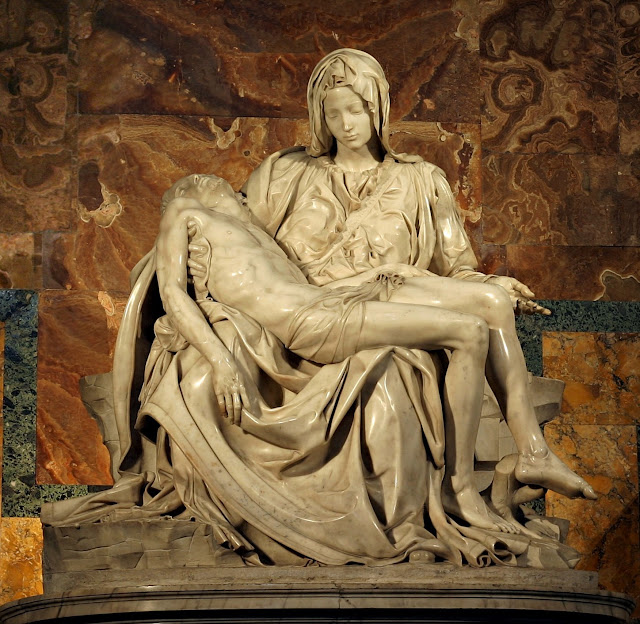 |
Michelangelo Buonarroti, The Pietà Italian, 1499 Vatican, St. Peter's Basilica |
The Entombment of Jesus
.jpg) |
Taddeo Gaddi, The Entombment of Jesus Italian, c.1335-1340 Florence, Church of Santa Croce, Cappella di Bardi di Vernio |
 |
Fra Angelico, The Entombment of Christ Italian, c. 1438-1440 Munich, Bayerische Stratagemädesammlungen, Alte Pinakothek |
.jpg) |
The Entombment of Jesus From a Speculum humanae salvationis French, c. 1450 Paris, Bibliotheque nationale de France MS Francais 188, fol. 51r |
 |
The Master of Hoogstraeten, The Burial and Lamentation of Christ Fifth Panel from the Left of the Seven Sorrows Altarpiece Flemish, c. 1510-1520 Antwerp, Royal Museum of Fine Arts |
 |
The Master of the Autun Triptych, The Entombment of Christ French, c. 1512-1530 Dolem, Musée des Beaux-Arts |
 |
Guercino, The Entombment of Christ Italian, 1656 Chicago, Arts Institute |
These are, however, entirely narrative images, and narrative images account for only a small percentage of the images of the Virgin Mary as the woman of sorrow, the Mater Dolorosa. 2
Art can be used to tell a story, as with narrative images. But, it can also transmit ideas and can do it, frequently, in a more direct and easily grasped form than can be done in words. As the old adage states, “One picture is worth a thousand words”. Consequently, several other modes of depicting the Sorrows of Mary have been used over time.
A Series of Pictures
One of the earliest modes was as a series of pictures, usually in manuscripts of the popular lay text the Speculum humanae salvationis, which was one of the “best-sellers” of the late medieval world. Through a combination of pictures and texts, lay people were offered a way to understand the Gospels and to meditate on aspects of the faith. These were not the carefully planned and painstakingly executed works that were intended for the clergy or the nobility, such as are found in service books, Gospel books or the numerous Books of Hours. These were quickly, even crudely executed works, that still have a certain ability to tell a story quickly through what amount to sketches. For the illustrations below I have chosen a few samples from different books of the first three of the Sorrows: the prophecy of Simeon, the Flight into Egypt and the Finding of Jesus in the Temple.
,%20c.%201370-1380_Paris,%20BNf_MS%20Latin%20511,%20fol.%2046r.JPG) |
The Flight into Egypt and Jesus Found in the Temple From a Speculum humanae salvationis French (Alsace), c. 1370-1380 Paris, Bibliotheque nationale de France MS Latin 511, fol. 46 |
 |
The Flight into Egypt and Jesus Found in the Temple From a Speculum humanae salvationis French, c. 1450 Paris, Bibliotheque nationale de France MS Francais 188, fol. 50 |
Later, as printing replaced illumination painters produced cycles of paintings of the individual sorrows, as well as paintings that contain references to the seven, as I will discuss later.
The Mater Dolorosa
Another early development was to, in effect, extract the image of the sorrowing Virgin Mary from images of the Crucifixion and place her upper body in the center of the picture frame. This gives us the image known as the Mater Dolorosa, the Sorrowing Mother. This image became most popular first in the Low Countries in the fifteenth century and eventually spread throughout Europe with repercussions all the way into the twentieth century.
,%20c.%201450s_London,%20National%20Gallery.jpg) |
The Mater Dolorosa Spanish (Valencia), c. 1450s London, National Gallery |
,%201473_New%20York,%20Pierpoont%20Morgan%20Library_MS%20M%20677,%20fol.%2038r.jpg) |
Jean Colombe, The Mater Dolorosa opposite a text of the Stabat Mater From the Hours of Anne of France French (Bourges), 1473 New York, Pierpoont Morgan Library MS M 677, fol. 38r |
 |
Hans Memling, The Mater Dolorosa German, c. 1480-1490 Florence, Gallerie degli Uffizi |
 |
Simon Marmion, The Mater Dolorosa French, 1480 Strasbourg, Musée des Beaux-Arts |
 |
Workshop of Dirk Bouts, The Mater Dolorosa Dutch, c. 1410-1475 Chicago, Art Institute |
 |
Paolo de San Leocadio, The Mater Dolorosa Italian, c. 1482-1484 Madrid, Museo Nacional del Prado |
 |
Titian, The Mater Dolorosa with Closed Hands Italian, 1554 Madrid, Museo Nacional del Prado |
 |
Titian, The Mater Dolorosa with Open Hands Italian, 1555 Madrid, Museo Nacional del Prado |
 |
El Greco, The Mater Dolorosa Greco-Spanish, c. 1590s Strasbourg, Musée des Beaux-Arts |
 |
Jusepe de Ribera, The Mater Dolorosa Spanish, 1638 Kassel, Staatliche Museen |
,%20Ashmolean%20Museum%20of%20Art%20and%20Archeology.jpg) |
Studio of Sassoferrato, The Mater Dolorosa Italian, c. 1650 Oxford (UK), Ashmolean Museum of Art and Archeology |
Over time the focus moved from the face and hands to the entire body of the Virgin Mary and references to the Passion were added but, for the most part, artists still concentrated on a close up view of Mary's mourning.
 |
Philippe de Champaigne, The Virgin of Sorrows at the Foot of the Cross Flemish, c. 1650 Paris, Musée du Louvre |
 |
Italian, 1657 Braunschweig, Herzog Anton Ulrich Museum |
 |
Spanish, c. 1660-1670 Madrid, Museo Nacional del Prado |
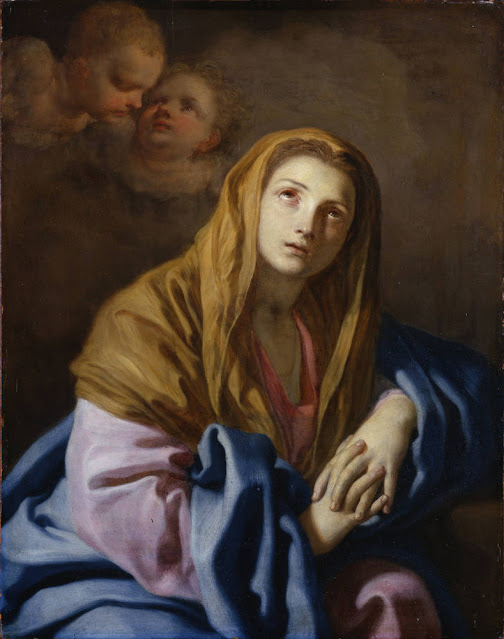 |
Francesco Solimena, The Mater Dolorosa Italian, c. 1723 Dresden, Staatliche Kunstsammlungen, Gemäldegalerie Alte Meister |
 |
Rosalba Carriera, The Mater Dolorosa Italian, c. 1720-1750 Dresden, Staatliche Kunstsammlungen, Gemäldegalerie Alte Meister |
 |
Christoforo Unterperger, The Virgin of Sorrows Surrounded by Angels Italian, c. 1780 Paris, Musée du Louvre |
 |
Johann Peter Krafft, The Mater Dolorosa Austrian, c. 1840-1850 Vienna, Belvedere Museum |
 |
Spanish. c. 1840 Madrid, Museo Nacional del Prado |
In the aftermath of the First World War artists expressed the grief of millions of mothers by referring back to the image of the Mater Dolorosa.
 |
Jakob Smits, The Mater Dolorosa Dutch, c. 1920s Brussels, Musées royaux des Beaux-Arts de Belgique |
 |
Irish, 1926 Dublin, National Gallery of Ireland |
Although the subject of the Mater Dolorosa is primarily expressed through painting, sculptors also contributed to this iconography, usually with full length statues, but sometimes with bust or half-length images. Like the painted images, this sculptural tradition developed from representations of the Virgin Mary at the Crucifixion.
 |
Virgin from a Deposition Scene Italian, c. 1225-1250 Paris, Musée du Cluny, Musée nationale du Moyen Age |
 |
The Mater Dolorosa Flemish, c. 1500-1520 Paris, Musée du Louvre, Département des Sculptures du Moyen Age, de la Renaissance et des temps modernes |
 |
The Mater Dolorosa Fragment of an Altarpiece French, c. 1520 Paris, Musée de Cluny, Musée nationale du Moyen Age |
 |
Germain Pilon, The Mater Dolorosa French, c. 1586 Paris, Musée du Louvre, Département des Sculptures du Moyen Age, de la Renaissance et des temps modernes |
 |
Francois Girardon, The Mater Dolorosa French, 1657 Paris, Musée du Louvre |
,%2017th-18th%20Century_Cleveland,%20Museum%20of%20Art.tif) |
Our Lady of Sorrows Spanish Colonial (New Mexico), 17th-18th Century Cleveland, Museum of Art |
The Man of Sorrows and the Mater Dolorosa
A similar image of Mary as the Mater Dolorosa was occasionally paired with the image of Jesus as the Man of Sorrows. This was sometimes done within a single picture (a painting or a print) or it may be accomplished by a diptych, a two-panel hinged format. In seventeenth-century Spain, it frequently took the form of highly realistic, bust or three-quarter figural sculptures.
 |
The Master of the Stories of Mary in Aachen, The Man of Sorrows and the Mater Dolorosa German, c. 1485 Aachen, Domschatzkammer |
 |
After Lucas van Leyden, The Man of Sorrows and the Mater Dolorosa Dutch, 16th Century Amsterdam, Rijksmuseum |
 |
Hans Holbein the Younger, Diptych with Christ as the Man of Sorrows and the Mater Dolorosa German, c. 1520 Basel, Kunstmuseum |
 |
Adriaen Isenbrant, Ecce Homo with the Mourning Virgin Flemish, c. 1530-1540 New York, Metropolitan Museum of Art |
 |
Bartolome Esteban Murillo, The Man of Sorrows and the Mater Dolorosa Spanish, c. 1670-1675 Private Collection |
.jpg) |
Pedro de Mena, The Ecce Homo and the Mater Dolorosa Spanish, c. 1674-1685 New York, Metropolitan Museum of Art |
The Mater Dolorosa Pierced by a Sword
- Another group of images takes the subject of Our Lady of Sorrows in a different, more symbolic direction. This is the group that I call The Sword-Pierced Mater Dolorosa. In these images the Virgin Mary is pierced, or about to be pierced, with swords, numbering anywhere from one to seven. They offer a literal interpretation of the words of Simeon from Saint Luke's Gospel, including images in which the sword approaches her directly from the body of Christ on the Cross. For these, she can be either sitting or standing.
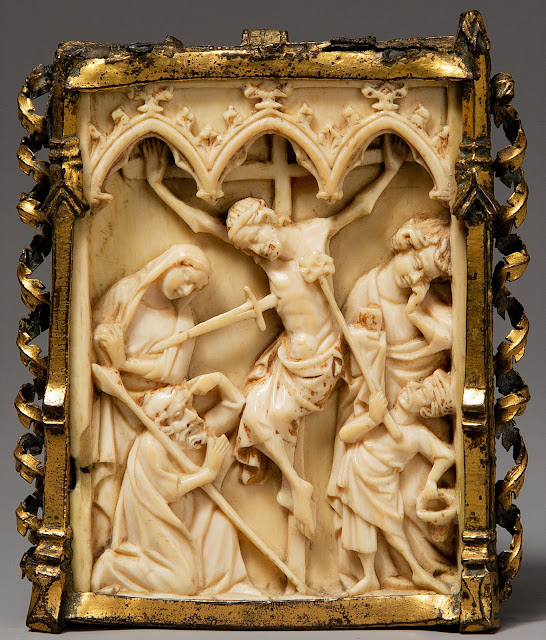 |
Ivory Pax with the Crucifixion, Mary Pierced by a Sword South German, c. 1360-1370 New York, Metropolitan Museum, The Cloisters Collection |
A pax is an object long out of use in the Catholic liturgy. Paxes were small plaques with scenes from the Passion or scenes with Eucharistic references that were passed among the congregation at Mass following the consecration, where today we give the sign of peace. However, it also sometimes served as a substitute for the Eucharist itself. In the middle ages the laity did not usually receive Holy Communion except at Easter. The pax was a very inadequate substitute for the actual Eucharist, but it did give people a small sense of participation in this part of the liturgy, while allowing them to skip the very strict Eucharistic fast. With the encouragement of frequent Communion for the laity that was ushered in following the reforms of the Council of Trent the pax was mostly abandoned. 4
,%20Catholic%20Parish%20Church%20of%20Saint%20Ludgarus.jpg) |
Our Lady of Sorrows Pierced by Swords German, 15th Century Sendenhorst (Kreis Warendorf), Catholic Parish Church of Saint Ludgarus |
.jpg) |
The Crucifixion, Mary Pierced by a Sword From a Speculum humanae salvationis French, c. 1450 Paris, Bibliotheque nationale de France MS Francais 188, fol. 50v |
 |
Anonymous, Mary Pierced by Seven Swords Netherlandish, c. 1500-1525 London, Trustees of the British Museum |
.jpg) |
The Mater Dolorosa Flemish, First Half of the 16th Century Antwerp, Royal Museum of Fine Arts |
 |
Our Lady of Sorrows with Donors French, c. 1500-1525 Champlitte, Parish Church of Saint Christopher |
 |
The Master of the Goslar Sibyls, The Man of Sorrows and the Mater Dolorosa (close up view) Chapel of the Trinity German, c. 1501-1515 Goslar, Rathaus, Reception Hall |
 |
Mary Pierced by Seven Swords German, c. 1510-1520 Euskirchen, Elsig, Catholic Parish Church of the Holy Cross |
 |
The Master of Hoogstraeten, Mary Pierced by a Sword Sixth Panel from the Left of the Seven Sorrows Altarpiece Flemish, c. 1510-1520 Antwerp, Royal Museum of Fine Arts |
 |
Hans Springinklee, Our Lady of Sorrows as the Garden of the Soul German, 1518 Dresden, Staatliche Kunstsammlungen, Kupferstich-Kabinett |
 |
Jacob Conneliszoon, Our Lady of Sorrows From Die Kleine Passion Dutch, c. 1520-1521 Dresden, Kupferstich-Kabinett |
,%20c.%201525_The%20Hague,%20Museum%20Meermano_MS%20MMW%2010%20E%204-078r.jpg) |
Mary Pierced by the Sword at the Foot of the Cross From a Prayer Book Flemish (Antwerp), c. 1525 The Hague, Museum Meermano MS MMW 10 E 4-078r |
,%20c.%201525-1530_NY,%20Pierpont%20Morgan%20Library_MS%20M%201175,%20fol.%20215r.jpg) |
Workshop of the Master of the David Scenes in the Grimani Breviary, Stabat Mater Illustration From a Book of Hours Flemish (Bruges), c. 1525-1530 New York, Pierpont Morgan Library MS M 1175, fol. 215r |
 |
Johann Sadeler after Christoph Schwarz, Mary Pierced by the Sword German, c. 1588 -1595 Amsterdam, Rijksmuseum |
 |
Bronze Morse (clasp for a cope), Mary Pierced by Seven Swords Between Two Saints Spanish, 17th Century Ecouen, Musée national de la Renaissance |
 |
Our Lady of Sorrows (Notre Dame du Pitie) Detail of an Altarpiece French, 17th Century Figeac, Chapelle Notre-Dame-du-Pitie |
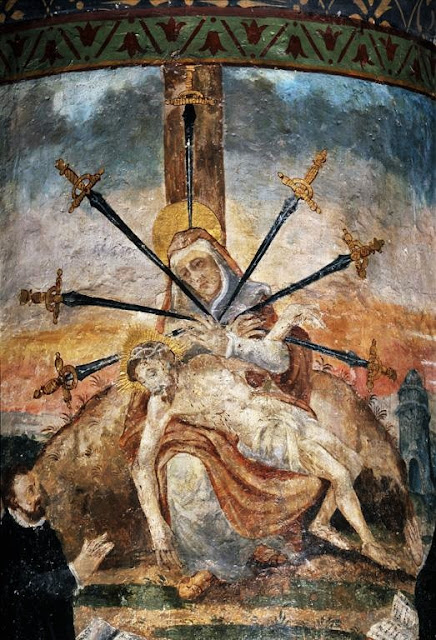 |
Our Lady of Sorrows French, 17th Century Laon, Church of Notre-Dame |
.jpg) |
Our Lady of Sorrows as the Pietà German, 17th Century London, Victoria and Albert Museum |
 |
Pierre Firens, The Seven Sorrows of Mary Franco-Flemish, c. 1600-1639 Amsterdam, Rijksmuseum |
 |
Possibly Peeter van Baelen, The Virgin of the Seven Sorrows Flemish, c. 1600-1635 Paris, Musée du Louvre, Département des Objets d'art du Moyen Age, de la Renaissance et des temps modernes |
 |
Peter Overadt, The Mater Dolorosa German, c. 1601 Wolfenbüttel, Herzog August Bibliothek |
 |
Schelte Adamszoon Bolswert, After Abraham Bloemaert, Mary Pierced by Seven Swords Dutch, c. 1612-1615 Amsterdam, Rijksmuseum |
 |
Cornelis de Vos, The Mater Dolorosa Flemish, 1620 Antwerp, Royal Museum of Fine Arts |
 |
Antoon Paydherbe, Our Lady of the Seven Sorrows Flemish, 1626 Mechelen, Onze-Lieve-Vrouw-over-de-Dijlekerk |
 |
| Frederic Brentel, The Mater Dolorosa From the Hours of Guillaume de Bade French, 1647 Paris, Bibliotheque nationale de France MS Latin 10567, p. 256 |
 |
Cornelis Galle After Anthony van Dyck, The Mater Dolorosa Flemish, Before 1650 San Francisco, Fine Arts Museums of San Francisco |
 |
Cornelis Van Poelenburg, The Mater Dolorosa Dutch, c. 1630-1665 Munich, Bayerische Staatsgemäldesammlungen, Alte Pinakothek |
.jpg) |
Paolo Naldini, Our Lady of Sorrows Italian, c. 1639 Rome, Church of San Marcello al Corso, Capella della Madonna dei Sette Dolori |
 |
Giovanni Battista Gaulli Called Baciccio, Our Lady of Sorrows with Saints Augustine and Nicholas of Tolentine Italian, c. 1650-1709 Paris, Musée du Louvre, Département des Arts graphique |
 |
Willem van der Leeuw After Peter Paul Rubens, The Mater Dolorosa Flemish, Before 1665 Antwerp, Royal Museum of Fine Arts |
 |
Italian, c. 1700 Private Collection |
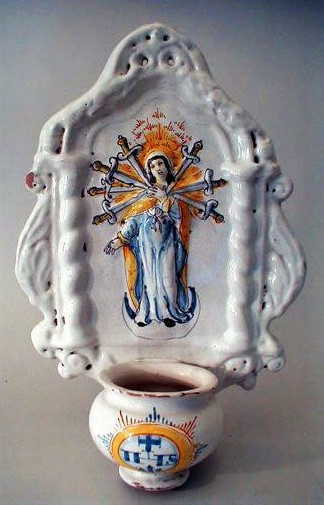 |
Holy Water Font with Our Lady of Sorrows Italian, 18th Century Saint-Omer, Musée de l'hôtel Sandelin |
,%2018the%20Century_New%20York,%20Metropolitan%20Museum%20of%20Art%20(2).jpg) |
The Virgin of Sorrows Spanish Colonial (Possibly Mexican), 18th Century New York, Metropolitan Museum of Art |
 |
The Virgin of Sorrows Spanish Colonial (Possibly Mexican), 18th Century New York, Metropolitan Museum of Art |
 |
Domenico Noferi, The Madonna dell'Adolorata Italian, 1754 Florence, Church of Santissima Annunziata |
 |
Miguel Cabrera, Our Lady of Sorrows Surrounded by the Trinity, Various Saints and the Souls in Purgatory Mexican, c. 1760 Location Unknown |
 |
Jose Camaron Bonanat, La Dolorosa Spanish, c. 1785-1790 Madrid, Museo Nacional del Prado |
 |
Our Lady of Sorrows French, c. 1800-1850 Brehan, Church of Notre-Dame |
 |
Our Lady of Sorrows Ring Italian, c. 1800-1850 London, Victoria and Albert Museum |
 |
Louis Stanislas Marin-Lavigne After Murillo, The Mater Dolorosa French, c. 1830-1860 Edinburgh, National Galleries of Scotland, Scottish National |
 |
Notre-Dame des Sept Douleurs Lithograph French, c. 1875-1900 Epinal, Musée de l'image |
 |
D. Darquet, Stained Glass of Our Lady of Sorrows French, 1879 Villers-Bocage, Parish Church of Saint Georges |
 |
Vicente Aznar, Our Lady of Sorrows Spanish, 19th Century Madrid, Biblioteca Nacional de Espaňa |
 |
John Singer Sargent, The Sorrowful Mysteries of the Rosary American, c. 1890-1916 Boston, Boston Public Library |
 |
Statue of Our Lady of Sorrows French, c. 1895 Thorame-Bass, Parish Church |
 |
Spanish, Contemporary |
The Seven Sorrows
The final category consists of paintings that attempt to show the image of Mary, either the Sorrowing Mother or the Sword-Pierced Woman, surrounded by depictions of the Seven Sorrows themselves. This image seems to have been popular from about the beginning of the fifteenth century to about the middle of the sixteenth century, with some late appearing outriders. It exists in all media: miniature painting, panel painting, enamels, drawings and prints, nearly all of them hailing from northern Europe. No doubt there are (or were) images in the medium of sculpture as well. We must bear in mind that there was a great deal of destruction wrought on images in northern Europe during the Reformation and its aftermath. The media mentioned above are easier to transport and to hide than all but the smallest items of sculpture. So, there has likely been disproportionate damage to sculpture in those countries where this particular image has been most prevalent.
,%20c.%201425-1450_London,%20British%20Library_MS%20Additional%2019416,%20fol.%208v.jpg) |
Jean le Tavernier, The Seven Sorrows of Mary From a Book of Hours Flemish (Ghent), c. 1425-1450 London, British Library MS Additional 19416, fol. 8v |
 |
The Master of Isabella di Chiaromonte, The Seven Sorrows of Mary From a Book of Hours Dutch (Delft), 1460-1520 New York, Pierpont Morgan Library MS M 71, fol.12v |
 |
The Master of Cornelis Croesinck, The Seven Sorrows of Mary From the Croesinck Hours Dutch, 1489-1499 New York, Pierpont Morgan Museum MS M 1078, fol.104v |
 |
Albrecht Durer, The Seven Sorrows of Mary German, c.1496 Munich, Bayerische Staatsgemäldesammlungen, Alte Pinakothek |
 |
Master S, The Seven Sorrows of Mary Flemish, c. 1600 Dresden, Sächsische Landesbibliothek |
 |
Master S, The Seven Sorrows of Mary Flemish, c. 1500-1525 London, Trustees of the British Museum |
 |
Simon Bening, The Seven Sorrows of Mary From the Da Costa Hours Belgian (Bruges), 1510-1520 New York, Pierpont Morgan Library MS M 399, fol. 92v |
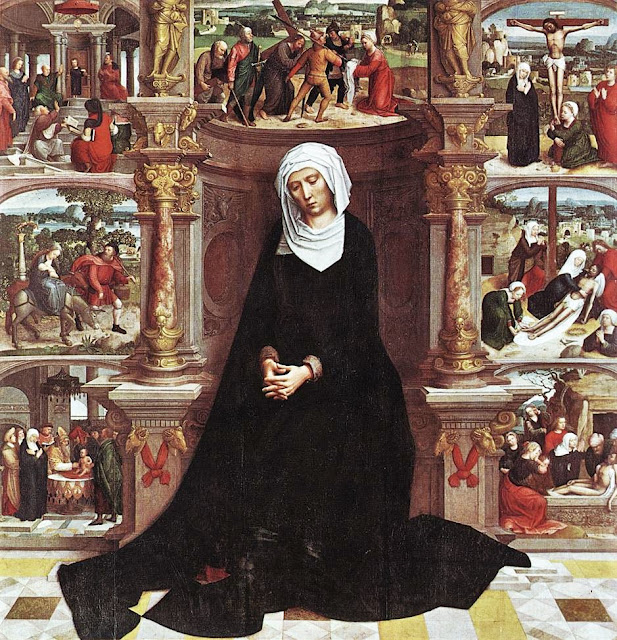 |
Adriaen Isenbrandt, The Seven Sorrows of Mary Flemish, 1518-1535 Bruges, Church of Our Lady |
 |
Monogrammist S, The Seven Sorrows of Mary Dutch, c. 1516-1545 Amsterdam, Rijksmuseum |
 |
Herik Douverman, Altar of the Seven Joys and the Seven Sorrows Dutch, c. 1518-1522 Kalkar Kreis Kleve, Catholic Parish Church of Saint Nicholas |
 |
Bernard van Orley, Center Panel of the Triptych of Our Lady of Seven Sorrows Flemish, c. 1520-1535 Besancon, Musée des Beaux-Arts et d'Archeologie |
 |
Adriaen Ysenbrandt, The Virgin of the Seven Sorrows Flemish, 1521 Brussels, Royal Museum of Fine Arts of Belgium |
 |
Bernard van Orley, The Seven Sorrows of Mary Flemish, 1526 Antwerp, Royal Museum of Fine Arts |
 |
Jan Baegert, The Seven Sorrows of Mary German, c. 1528-1530 Cologne, Kunstmuseum des Erzbistums Köln |
 |
Workshop of Pierre Reymond, Enamel Plaque with the Seven Sorrows of Mary and Two Donors France, 1533 New York, The Frick Collection |
 |
Giorgio Ghisi, The Mater Dolorosa Surrounded by the Seven Sorrows Italian, c. 1575 Philadelphia, Museum of Art |
 |
The Master of the Half-Lengths, The Virgin of the Seven Sorrows Flemish, Late 16th Century Barcelona, Museu Nacional d'Art de Cataluňa |
 |
Our Lady of the Seven Sorrows French, 17th Century Bourg-en-Bresse, Church of Saint-Nicolas-de-Tolentin |
 |
Workshop of Penicaud, Enamel Plaque of Our Lady of the Seven Sorrows French, c. 1615 London, Trustees of the British Museum |
 |
Paul Fürst, The Seven Sorows of Mary German, 1626 Wolfenbüttel, Herzog August Bibliothek |
Devotion to Our Lady of Sorrows
Devotion to Mary under the title of Our Lady of Sorrows was initially associated with the religious Order of the Servants of Mary, called the Servites. They were founded in 1233 by a group of seven pious laymen who were Florentine wool merchants. They had belonged to a lay confraternity with a devotion to Mary. However, like their contemporary Saint Francis, they gave up their prosperous careers and retreated to a village outside Florence where they established a religious community. Eventually they made their way to a nearby mountain and laid the foundations for a religious order of men. It was given approval by the bishop of Florence at some point in the mid-1240s as the Order of Friars Servants of Mary.
 |
Our Lady of Sorrows German, c. 1750-1800 Motten. Parish Church of St. Matthew |
One of the primary factors in the spirituality of the Servites over the centuries has been devotion to Mary as Our Lady of Sorrows, as the Mater Dolorosa. Their black habit was established as a reminder of Mary’s dress as a widow. In 1692 Our Lady of Sorrows was officially declared to be the patroness of the order.3
© M. Duffy, 2017, Revised with addition of material and new images, 2022.
______________________________________________________
* “Now, Master, you may let your servant go in peace, according to your word,
for my eyes have seen your salvation,
which you prepared in sight of all the peoples,
a light for revelation to the Gentiles,
and glory for your people Israel.” (Luke 2:29-32)
1. This neat listing of the sorrows with their accompanying text references comes from https://www.catholicculture.org/culture/liturgicalyear/calendar/day.cfm?date=2017-09-15
2. Mary, as the Mater Dolorosa, has also been described in poetry, specifically the poem called the Stabat Mater, usually attributed to the Franciscan Jacopone da Todi toward the end of the thirteenth century, which imagines the scene at the foot of the Cross, imagines Mary’s reaction to what is happening and prays to be united with her in her sufferings. It has been set to music by many composers, including Palestrina, Vivaldi, Pergolesi, Haydn, Rossini, Poulenc and Arvo Part, to name just the ones I’m personally familiar with. A chant version (with an English translation) is probably familiar to many since it is often used during communal celebration of the Stations of the Cross. It is also one of the few surviving sequences (hymns that precede the reading of the Gospel on feast days), being an optional sequence for the feast of Our Lady of Sorrows. See https://www.stabatmater.info/ A sampling of various settings of the words can be found at https://www.youtube.com/results?search_query=stabat+mater
3. For information about the Order of Servites see http://www.servite.org/Meehan, Andrew. "Pax." The Catholic Encyclopedia. Vol. 11. New York: Robert Appleton Company, 1911. http://www.newadvent.org/cathen/11594b.htm
Scripture texts in this work are taken from the New American Bible, revised edition © 2010, 1991, 1986, 1970 Confraternity of Christian Doctrine, Washington, D.C. and are used by permission of the copyright owner. All Rights Reserved. No part of the New American Bible may be reproduced in any form without permission in writing from the copyright owner.
,%20c.%201350-1400_Paris,%20Bibliotheque%20nationale%20de%20France_MS%20Arsenal%20593,%20fol.%2039v.jpg)
,%20c.%201485_Paris,%20Bibliotheque%20nationale%20de%20France_MS%20Francais%206275,%20fol.47r.jpg)

,%20c.%201470-1480_Oxford,%20University%20of%20Oxford,%20Bodleian%20Libraries_MS%20Rawl.%20liturg.%20d.%206,%20fol.%2042v.jpg)
.jpg)

,%20Norfolk%20Castle%20Museum%20and%20Art%20Gallery%202%20(2).jpg)

2 comments:
I'd build, Madonna, love, for my belief,
An altar in the dim crypt of my grief,
And in the darkest comer of my heart,
From mortal lust and mockery far apart,
Scoop you a niche, with gold and azure glaze,
Where you would stand in wonderment and gaze,
With my pure verses trellised, and all round
In constellated rhymes of crystal bound:
And with a huge tiara richly crowned.
Out of the Jealousy which rules my passion,
Mortal Madonna, I a cloak would fashion,
Barbarous, stiff, and heavy with my doubt,
Whereon as in a fourm you would fill out
And mould your lair. Of tears, not pearls, would be
The sparkle of its rich embroidery:
Your robe would be my lust, with waving flow,
Poising on tips, in valleys lying low,
And clothing, in one kiss, coral and snow.
In my Respect (for satin) you'll be shod
Which your white feet would humble to the clod,
While prisoning their flesh with tender hold
It kept their shape imprinted like a mould.
If for a footstool to support your shoon,
For all my art, I could not get the moon,
I'd throw the serpent, that devours my vitals
Under your trampling heels for his requitals,
Victorious queen, to spurn, bruise, and belittle
That monstrous worm blown-up with hate and spittle.
Round you my thoughts like candles should be seen
Around the flowered shrine of the virgins' Queen,
Reflected on a roof that's painted blue,
And aiming all their golden eyes at you.
Since nought is in me that you do not stir,
All will be incense, benjamin, and myrrh,
And up to you, white peak, in clouds will soar
My stormy soul, in rapture, to adore.
In fine, your role of Mary to perfect
And mingle barbarism with respect —
Of seven deadly sins, O black delight!
Remorseful torturer, to show my sleight,
I'll forge and sharpen seven deadly swords
And like a callous juggler on the boards,
Taking it for my target, I would dart
Them deep into your streaming, sobbing heart.
Fantastic
Post a Comment